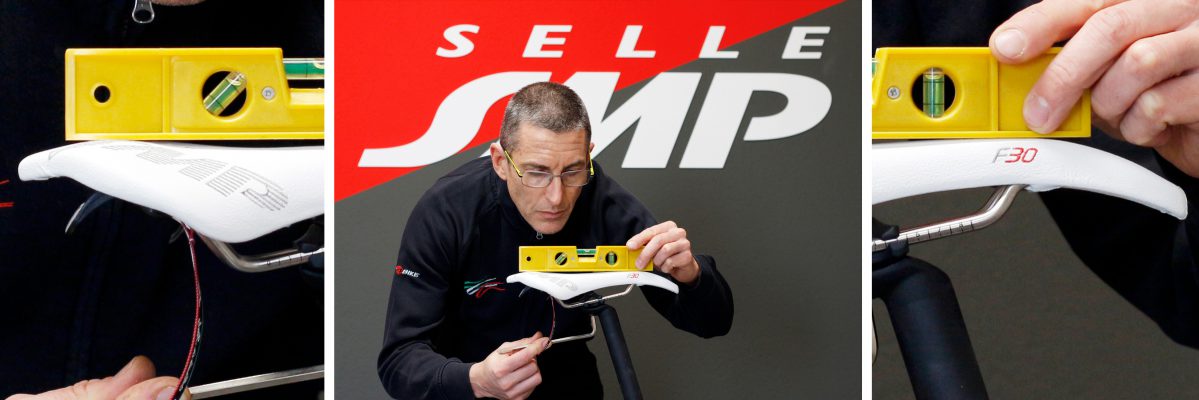
Selle SMP saddles are amazing. Our design is different: the tip is curved downwards, the central part has a very wide channel, the support surface has a special ergonomic shape and the rear part is slightly raised. All these features are important for comfort and should be considered when adjusting the Selle SMP saddle.
Selle SMP saddles: adjustment is fundamental and necessary for everyone
All saddles require minimum adjustment. But ours have something extra.
With Selle SMP saddles you don't have to adapt to the saddle! The saddle adapts to you. That's why it is even more important to adjust our saddles.
In short, you can’t just mount the saddle, jump onto the bike and go straight to the woods or on roads hoping that everything is ok. An incorrectly adjusted Selle SMP saddle cannot be comfortable, even if you have chosen the right model. It's like having the right pair of shoes but with the laces too tight: you're not comfortable!
At this stage of adjustment, your comfort is at stake. Because at this stage the saddle adapts to your body.
To find the right adjustment and tilt of the Selle SMP saddle you have two options:
• adjust and try the saddle on the road, even several times, until it feels yours and comfortable;
• go to a biomechanic
Positioning the Selle SMP saddle is easy
First of all, we start with assembling the saddle: we have already talked about this in this article. Once the saddle has been correctly mounted, we can move on to the adjustment stage. At this stage, you can refer to this guide which deals precisely with adjustment and tilt of the SMP saddle.
How do you know if Selle SMP saddles are adjusted correctly?
That’s easy: when you feel good on the saddle. Comfort cannot be explained in words: it is a combination of personal feelings. In addition, adjustment depends on many factors: the height of the Selle SMP saddle, the tilt, the position on the seatpost...
But we want to help you find the right adjustment, so we can give you some tips that can be good for all of you.
The Selle SMP saddle is well-adjusted when you feel comfortable in the saddle. It's like when you wear a tailor-made garment: it fits perfectly. This is how you should feel when you ride on one of our saddles: it must be designed on your body. There are no fixed rules, each of us is different, as we have our own physical build and pedalling style. The saddle must be adjusted to properly fit your natural shape and position.
The tilt of Selle SMP saddles and the retraction are the crucial part: as you can see in this video (and in the guide we have recommended above) the tilt ranges from +10 to -25 mm and the retraction of the Selle SMP saddle (compared to the handlebar) can be up to -15 mm.
After levelling the saddle, we generally recommend tilting it down about 10 mm and starting to pedal. Fine adjustment always takes place on the road, so never forget to take the key with you and, if necessary, change the tilt and retraction according to how comfortable you feel.
Here are some typical situations that will allow you to understand that you need to adjust the saddle again.
• Tendency to slide: If you tend to slide forward, you may have exaggerated the tilt of the saddle and ended up lowering the tip too much. Try raising the saddle tip a few degrees at a time; stop as soon as the tendency to slide stops.
• Underseat pressure: If you feel pressure on the perineal parts, the saddle tip is too high for your needs. Try lowering the saddle tip a few degrees at a time; stop as soon as the tendency to slide stops.
• Tendency to move forward on the saddle: if you pedal on flat terrain, you notice that you tend to move forward on the saddle. It means that the saddle is too far back. Try pushing the saddle forward a couple of millimetres at a time, without changing the tilt of the saddle. Stop as soon as you no longer have this sensation.
• You can feel the saddle pushing forward: this is a less common situation, however, it may occur when the saddle is too far forward. Try pushing the saddle forward a couple of millimetres at a time, without changing the tilt of the saddle. Stop as soon as you no longer have this sensation.
• Ischial bone pain: soreness in the ischial bones may be normal after several hours on the saddle, but it is not normal if it appears after a few kilometres or even as soon as you get on the saddle. After following the above advice, if you continue to feel soreness in the support area you are probably trying a Selle SMP saddle model that is not suitable for you. Don't worry: you can contact an SMP4TEST specialist dealer or contact our customer service department.
Once your SMP saddle is well-adjusted, you will feel comfort that you have never felt before, truly unique. Adjustment is the way to comfort and comfort is the key to reaching every finish line, in races and when training.
